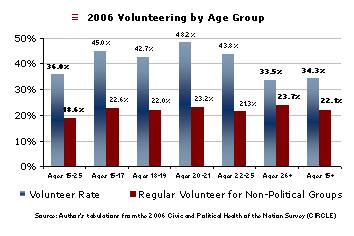Race, Gender, and Immigrant Status
This series of research products addresses youth civic engagement indicators based on race, ethnicity, gender and immigrant status.
RSSRace, Gender, and Immigrant Status
Quick Facts on Young Voters: 2004
by Mark Hugo Lopez, Emily Kirby, and Billy Grayson September 2005 Based on 1972-2004 Current Population Survey data. Provides quick summary of voting statistics from the 2004 election. Download “Quick Facts on Young Voters: 2004.”
Participation in Sports and Civic Engagement
by Mark Hugo Lopez and Kimberlee Moore February 2006 Based on the 2002 CIRCLE National Youth Survey. Download “Participation in Sports and Civic Engagement.“
Immigrant Youth Demographics

by Karlo Barrios Marcelo and Mark Hugo Lopez November 2006 Based on Current Population Survey data. Compares the numbers of 18-25 year-old immigrants by nativity status, gender, race, ethnicity, geographic distribution, country of origin, year of arrival, marital status, educational attainment, and assesses population trends from 1994-2006. Download “Immigrant Youth Demographics.”
Volunteering Among Young People

by Mark Hugo Lopez and Karlo Barrios Marcelo April 2007 Based on a variety of data sources including CIRCLE’s 2006 Civic & Political Health of the Nation survey, Monitoring the Future data from 1976-2005, HERI data from 1984-2005, & NELS data from 1988. Compares youth volunteering with that of other generations, tracks high school & Read More >
Around the CIRCLE–V.4 I.3 APRIL 2007

In this issue:
FOUR YEARS AFTER THE CIVIC MISSION OF SCHOOLS REPORT: A SUMMARY OF THE LATEST CIRCLE RESEARCH ON SCHOOL-BASED CIVIC LEARNING
In February of 2003, Carnegie Corporation of New York and CIRCLE issued a major report on the state of K-12 civic education entitled The Civic Mission of Schools (CMS). The report drew upon the best research from several disciplines and offered “six promising approaches” for effectively providing civic education. After the publication of the CMS report, CIRCLE and Carnegie helped to organize the Campaign for the Civic Mission of Schools, an advocacy effort. Composed of more than 40 organizations and funded by Carnegie Corporation of New York, the Knight Foundation, the Annenberg Foundation, and the Gates Foundation, among others, the Campaign works to increase federal and statelevel support for civic education. Its national advisory board is co-chaired by former Justice Sandra Day O’Connor and former Governor Roy Romer. The Campaign works closely with partners such as the Alliance for Representative Democracy, which has teams in every state, and the Education Commission of the States (ECS). This article provides a summary of the latest CIRCLE-funded research on the six promising approaches. Read more.
A LETTER FROM THE AUTHORS OF THE CIVIC
MISSION OF SCHOOLS REPORT
On behalf of Carnegie Corporation of New York and CIRCLE, we collaborated in 2002 and 2003 to organize The Civic Mission of Schools (CMS) report. Written by 60 authors, the report is probably best known for presenting evidence in favor of “six promising practices” for civic education in schools (see the cover article to this issue for recent evidence about those practices).
By 2003, there had been many evaluations of specific programs and types of programs, often with favorable results. Citing that body of research, The Civic Mission of Schools concluded that schools play an important role in helping young people gain the civic knowledge, skills, and attitudes they need to participate fully in our democracy. That conclusion mattered for public policy because preparing the next generation for active and responsible citizenship is a crucial, and often forgotten, purpose of public education. Read more.
Research Roundup:
CLASSROOMS PRODUCE POSITIVE CIVIC OUTCOMES FOR STUDENTS: RESULTS FROM A LONGITUDINAL STUDY OF CHICAGO PUBLIC SCHOOL STUDENTS
Joseph Kahne and Susan Sporte investigate civic outcomes among high school students in Chicago in their forthcoming article entitled, “Developing Citizens: A Longitudinal Study of School, Family, and Community Influences on Students’ Commitments to Civic Participation” (funded by the Spencer Foundation and the Chicago Community Trust). The most important finding is that what happens in classrooms has a meaningful impact on students’ commitment to civic participation. Read more.
THE CALIFORNIA SURVEY OF CIVIC EDUCATION: AN ASSESSMENT OF THE PREVALENCE AND IMPACT OF CIVIC EDUCATION ON GRADUATING SENIORS
The California Campaign for the Civic Mission of Schools (www.cms-ca.org) commissioned Joseph Kahne and Ellen Middaugh of Mills College to conduct the California Survey of Civic Education. This survey assessed the prevalence and impact of civic education practices in California’s high schools on graduating seniors throughout the state. Read more.
ECS STUDY REVEALS GAPS IN STATE-LEVEL POLICY REGARDING CIVIC EDUCATION
In June 2006, The Education Commission of the States (ECS) National Center for Learning and Citizenship (NCLC) conducted a policy scan to define the current state of citizenship education. The study found that states were emphasizing knowledge of civics and government, obtained through traditional classroom instruction. Civic knowledge is necessary, but not sufficient; citizens also need skills and dispositions to sustain and enhance American democracy. These three competencies—knowledge, skills and dispositions—are at the heart of civic education. Read more.
Research to Practice:
IN USE: THE CIVIC MISSION OF SCHOOLS REPORT
Four years after its original publication, The Civic Mission of Schools (CMS) report is being used daily to inform practice and influence policy. It is being widely disseminated and used in a number of innovative ways including serving as the basis for discussion at many state summits on civic education that have occurred since 2003; as required reading in teacher education courses; and, as an advocacy tool for those seeking to create or support civic education policy.Read more.





